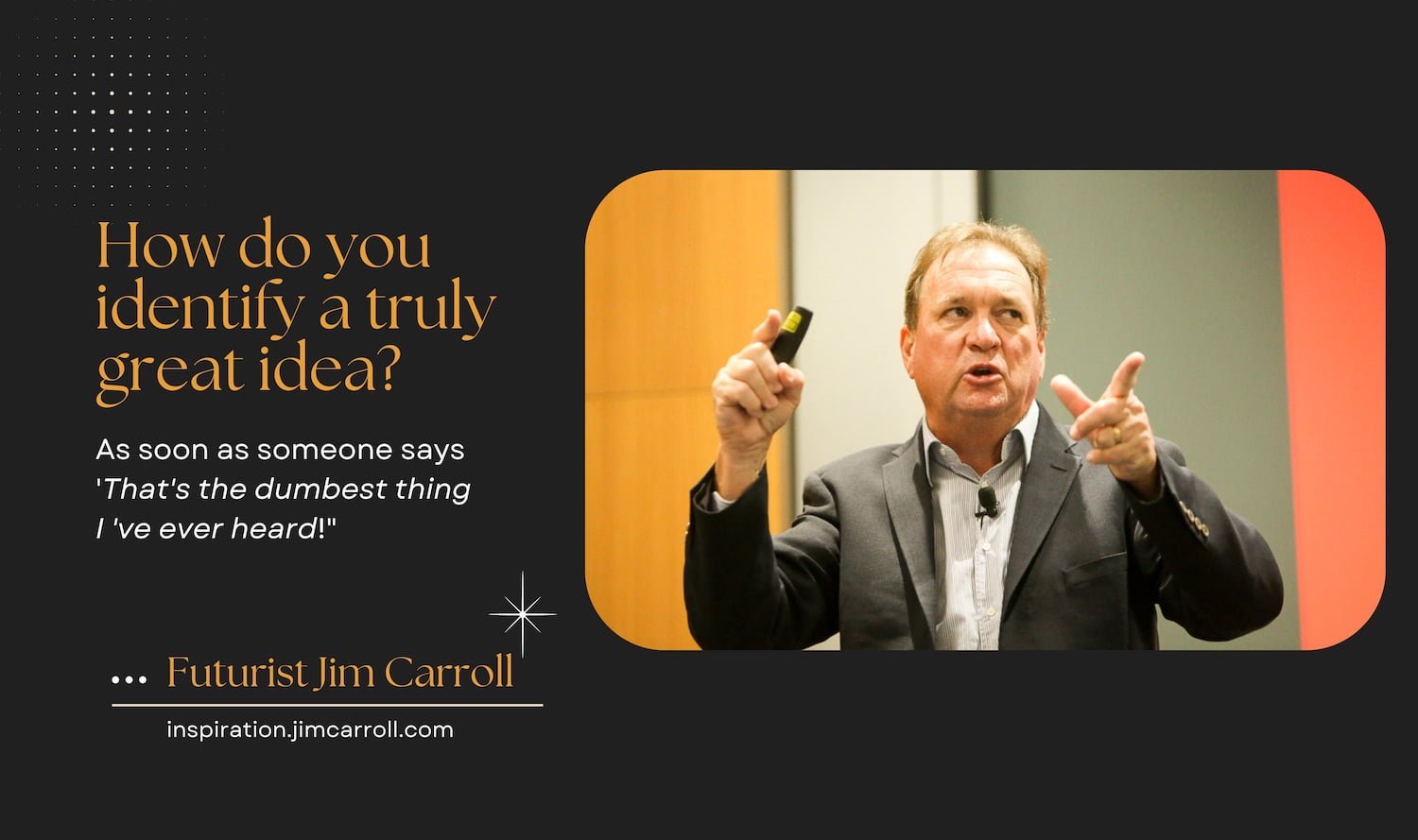“How do you identify a truly great idea? As soon as someone says ‘That’s the dumbest thing I’ve ever heard!'” – Futurist Jim Carroll

Every great idea was once the dumbest thing you ever heard!
I’ve said many times in the past, and I repeated it again during the Q&A portion of a virtual talk I gave the other day:
Q. “What early indicators should we look out for that would give us an indication that a once unproven technology, what is a big, bold idea that you referred to, is about to become widely adopted.”
A. “My answer to that would be when a lot of people are saying “That’s the dumbest thing I ever heard.”
I spent a little bit of time looking into the genesis of this idea, using my online research database tool. Lo and behold, I dub out this article from 2003 when I first began to use the phrase in the media. It’s a great article – and is evocative of a time when I was once again reinventing, shifting from focusing just on technology to the opportunities for disruptive, transformative thinking and innovation.
Despite years of cost-cutting, many organizations continue to operate with an alarmingly high-cost base, with scads of inefficient business processes built into the bureaucracy.
We reinvent the wheel over and over, unable to share ideas and information throughout the organization. We see valuable information walk out the door every time an employee leaves. We infuriate our customers through our inability to provide rapid, effective, intelligent customer support.
Why? Because we refuse to be innovative. We’ve got to get away from the past, and continue to reinvent ourselves for the future, through the application of all kinds of wildly innovative ideas as to how we work on a day-to-day basis.
Innovation implies courage, among other things. So how do you and your organization get into an innovative frame of mind?
Recognize that you’ve got to instill a sense of courage, a willingness to explore new things. The fact is, the current business climate certainly doesn’t encourage the emergence of any corporate innovation heroes. Indeed, it would seem that few of us have any gumption to try to do anything different, particularly given the carnage that emerged after the gung-ho nineties. Lots of new ideas there — and look what happened to all the folks who were on the leading edge! Who would dare try anything new?
Recognize that opportunity abounds for innovative approaches to our day-to-day routine. For example, given the vast range of sophisticated new technologies, there is no shortage of opportunities to continue to be innovative in the way that we utilize and share information within our organization. Have you taken a look at the hot new Internet technology known as Weblogs? They’re causing a lot of rethinking within the Internet community as to how to share information and there are plenty of opportunities there for sharing internal corporate knowledge.
Revisit opportunities to streamline business processes. What about that paper form that gets sent around the company, to be initialed and signed in duplicate and triplicate? There are plenty of inefficient business processes that surround us that could use a tune-up, with resulting efficiencies and cost savings. There are lots of innovative HR professionals who are busy putting in place sophisticated HR self-service employee portals which significantly streamline processes involving benefits management and other functions. Why aren’t you?
Constantly take a look at how you might provide more effective customer support. Innovative organizations continue to explore and implement sophisticated self-service solutions that help a call center rejig its approach to providing support during peak periods. Customers keep changing and are increasing their expectations as to the type of support you provide, so you’d better make sure that you are innovative in your response.
Take a look at your partners — suppliers and business associates. Are there unique ways that you might be able to partner with them to reduce costs, or simply make these inter-organization relationships work better?
All of these issues, and more, have little to do with the development of new products, yet are equally important in becoming an innovative organization.
Of course, you won’t succeed at all if you have a corporate culture that stops innovation dead in its tracks. If your executives are fond of statements such as “that’s the dumbest thing I ever heard,” “that’s not my problem,” “you can’t fix that” and “it won’t work,” then you’ve got a lot of work to do to develop a culture that supports innovative processes.
Smooth the wheels of innovation
28 November 2003, The Globe and Mail
To be a futurist is to be someone who is laughed at a lot. Mostly because people refuse to believe the accuracy of what we are telling them.
But, they stop laughing eventually.
LOL.




GET IN TOUCH
Jim's Facebook page
You'll find Jim's latest videos on Youtube
Mastodon. What's on Jim's mind? Check his feed!
LinkedIn - reach out to Jim for a professional connection!
Flickr! Get inspired! A massive archive of all of Jim's daily inspirational quotes!
Instagram - the home for Jim's motivational mind!